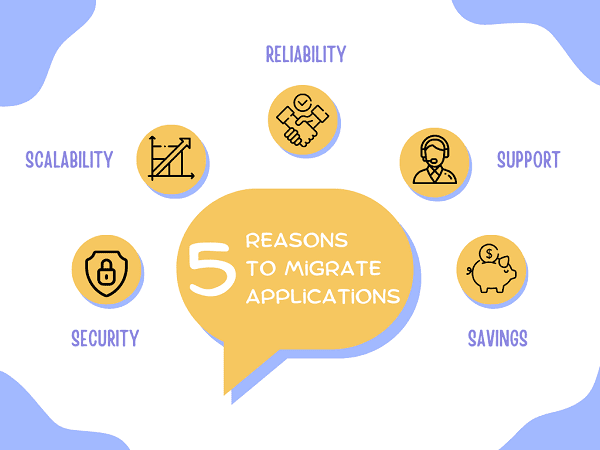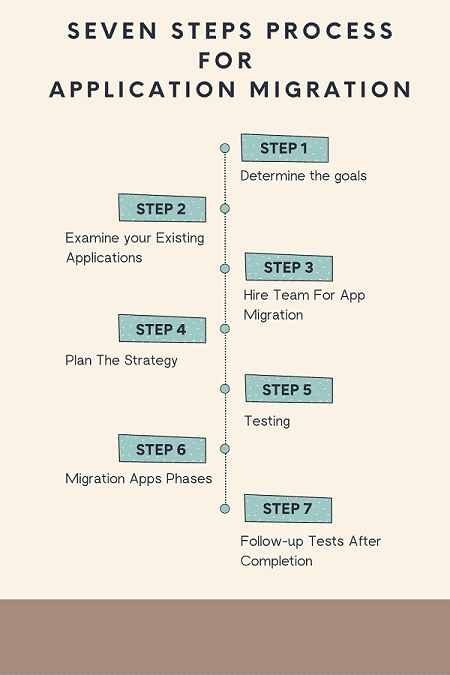Mobile Application Migration: An Ultimate Guide
Do you want to migrate your application to another platform due to performance and scalability problems? Did you need the team to concentrate on the core tasks rather than monitoring hardware?
No matter the reason, an application migration will provide seamless scalability, performance and improved security features. Many companies have often decided to switch to the latest computing environment due to the new technologies they started to utilize, business goals, or new development strategies.
In this article, you will delve into the depth of the application migration for your business.
What is a Mobile Application Migration?
Application migration means a shift of an app, host servers and the app-associated data from one computing environment to the cloud. Many enterprises have been undergoing this process. Hence, they migrate from on-premise services to public, private or hybrid cloud environments.
The public cloud environments give computing services over a shared internet connection, allowing all users to buy and use them without any obstacles. Private cloud environments permit organizations to manage and host cloud resources without sharing them with other users.
Hybrid cloud environments combine the features of public and private cloud environments. It grants authority to businesses to access the public cloud while keeping their data confidential. For simple and non-sensitive computing activities, companies are getting flexibility and computing capacity in the public cloud. Therefore, it securely maintains the on-site business apps and data behind the company firewall.
Reasons To Migrate Mobile Applications
Cloud is used for many objectives like web hosting, email hosting, content management, recovery and backup, security, monitoring and data management. It migrates the applications to the cloud and provides organizations with many benefits.

1. Security
It is the leading concern for the business as it moves the data online. However, cloud technology has proven highly secure and incomparable to the traditional on-premise infrastructure. This security system is handled by experienced cloud service providers who strive to meet a significant level of data protection standards. Whenever the business takes essential steps, it builds strong passwords and firewalls, pairs with cloud technology, and makes your data protected.
2. Scalability
Organizations with fluctuating demand and the app environment they select must be able to keep up with the pace. It allows businesses to scale up or down as per their need. Organizations do not need to make any permanent changes to their infrastructure, as it saves time and money. Businesses can get a high level of performance with a cloud service that can increase their bottom line.
3. Reliability
It is another benefit that businesses will do while migrating to the cloud. Cloud services give companies reliability and minimal downtime compared to the traditional on-premise system. A cloud vendor is responsible for keeping its system available around the clock, and the maintenance is done regularly. Many cloud vendors also consider the complications of accounts like timeouts, overflow and network failure before integrating any solution.
4. Support
A Flutter app migration is an ability for the company owners to place a greater focus on their core business. When the business opts to migrate to the cloud as they have the support of an experienced cloud vendor who is highly qualified to give the solutions and ongoing support. However, the time spent on managing IT is reduced with the cloud by giving business leaders much more time to grow their businesses.
5. Savings
Migrating to the cloud can help reduce IT infrastructure costs, which saves the business a lot of money in the long term. The flexibility of cloud services also permits a company to manage its needs while eliminating on-premises assets and unnecessary hardware.
Also, Read This Post:
5 Essential Tips For Developing A Secure Mobile App?
Different Types Of Mobile Application Migration
If you want to access the third-party application or replace the on-premise server with virtual machines, then the application migration can help. However, you must know the application migration type best fits your business needs.

1. Rehosting: Lift and Shift Application migration
In this case, you are moving to the hosting provider that fits your business needs as you will concentrate on the cloud environment, like an IaaS, to enhance app performance. In this style, you can easily migrate the apps with minimal architecture and implementation concerns.
2. Replatform: Rip and Replace Program Migration
In this way, you are upgrading a mobile application development process to a better-performing platform. For instance, moving on an on-premise application to the public cloud is attributed to re-platforming. In this case, you can review an entire architecture and revamp a software structure to suit a cloud provider’s environment.
3. Repurchasing: Drop and Shop App Migration
When you are moving your existing application to the SaaS platform, then it is referred to as repurchasing. In this case, the app is managed by a third-party application. When moving to SaaS, you do not need the resources to handle unexpected downtime and manage network infrastructure. With the help of a migration plan, you can define the new pricing plans.
4. Re-architect: Rip and Replace
Consider applying this application migration type when reviewing the existing application and identifying new technical requirements. For example, shifting from monolithic to virtual services is considered refactoring.
5. Retire: Drop and Shop
Suppose a large-scale business is dependent on compassionate data in that app migration is essential. It is efficient for companies to audit an existing system and identify software solutions that could be more useful. Hence, consider them a retirement for your business.
6. Retain: Keep and Consider
It is essential to retain only those of the on-premises solutions which have become possible in the cloud-native apps. It can match your new needs and the various aspects before considering them as retention.
Steps For Mobile Application Migration
Defining the strategy to shift your app to a targeted environment is necessary. Let’s take a look at a step-by-step process for the same.

1. Determine the goals
To identify a migration plan, you are required to examine migration goals. It will help with a migration type and move in the proper direction. An objective is to improve cloud performance or enhance operations. Hence, it will cut costs and identify a migration path and plan.
2. Examine your Existing Applications
Before moving forward with the app migration, you must check an existing system and assess its worthiness. It would support you in examining whether you want to retain, refactor or remove the system from existence. During the evaluation stage, check if the current system is usable. It helps you to update the operating system to newer versions during an assessment.
3. Hire Team For App Migration
Once you have audited your apps, you require to guide you with the app migration. The skilled pp migration consultations will validate your ideas and recommend a roadmap on how to proceed.
if you are looking to migrate your existing mobile app into the flutter platform, hire flutter developer from the flutter agency to successfully migrate your existing app to flutter without losing any data. Flutter developers will help you to migrate your app into flutter technology doesn’t matter in which technology your app has been developed.
4. Plan The Strategy
During the application migration process, an app developer will check the documentation created on system evaluation. The experienced and skilled app migration consultants will find technical requirements, analyze the feasibility and check migration tools for migrating your apps.
An app migration expert will move it from an existing environment to the cloud with the help of these tools. It identifies the tools needed for analytics and monitoring, which helps you plan better.
5. Testing
The developer does the mock migration before moving ahead with the actual migration process. It helps to know your devised strategy that will work entirely in your case.
When app migration developers migrate directly in the real-time environment, they may find an issue that needs immediate attention. Hence, it captures the issues early and modifies data migration direction for a better outcome.
6. Migration Apps Phases
Now it is time to move your app to an alternate environment. You can not complete app migration in one go. Therefore, the phases redefine, which is iterative to conduct a whole migration. The app migration developers can migrate every part using relevant tools. It helps stakeholders to remain in the loop and manage the migration.
7. Follow-up Tests After Completion
To know that migration is successful, experts perform the Follow-up test in your app. It checks an app’s performance in the other environment. At the same time, you can prevent application usability disruptions with these tests. Hence, the developers also check database security in the new environment.

Conclusion
Application migration helps you reduce operational costs and increase software performance. Selecting a suitable application migration strategy is necessary for shifting the software to another environment.
Frequently Asked Questions (FAQs)
1. What Are the Types of Process migration?
There are two kinds of Process Migration:
Non-preemptive process: If a function is shifted before it starts execution on its source node, it is non-preemptive.
Preemptive process: If this process is moving ahead at the time of execution, it is called a preemptive process.
2. Why do the migrations fail?
The most common cause behind cloud migration failure is the need for panning. With proper planning, the app migration is booming, and it has to bear the loss of money.
3. What will app migration do?
The experts are moving existing applications to the newer environment in application migration projects. It could be another data center or an application environment, depending on the requirements of the software solution.
Contemporary ventures
Recent blog
ready to get started?
Fill out the form below and we will be in touch soon!
"*" indicates required fields








